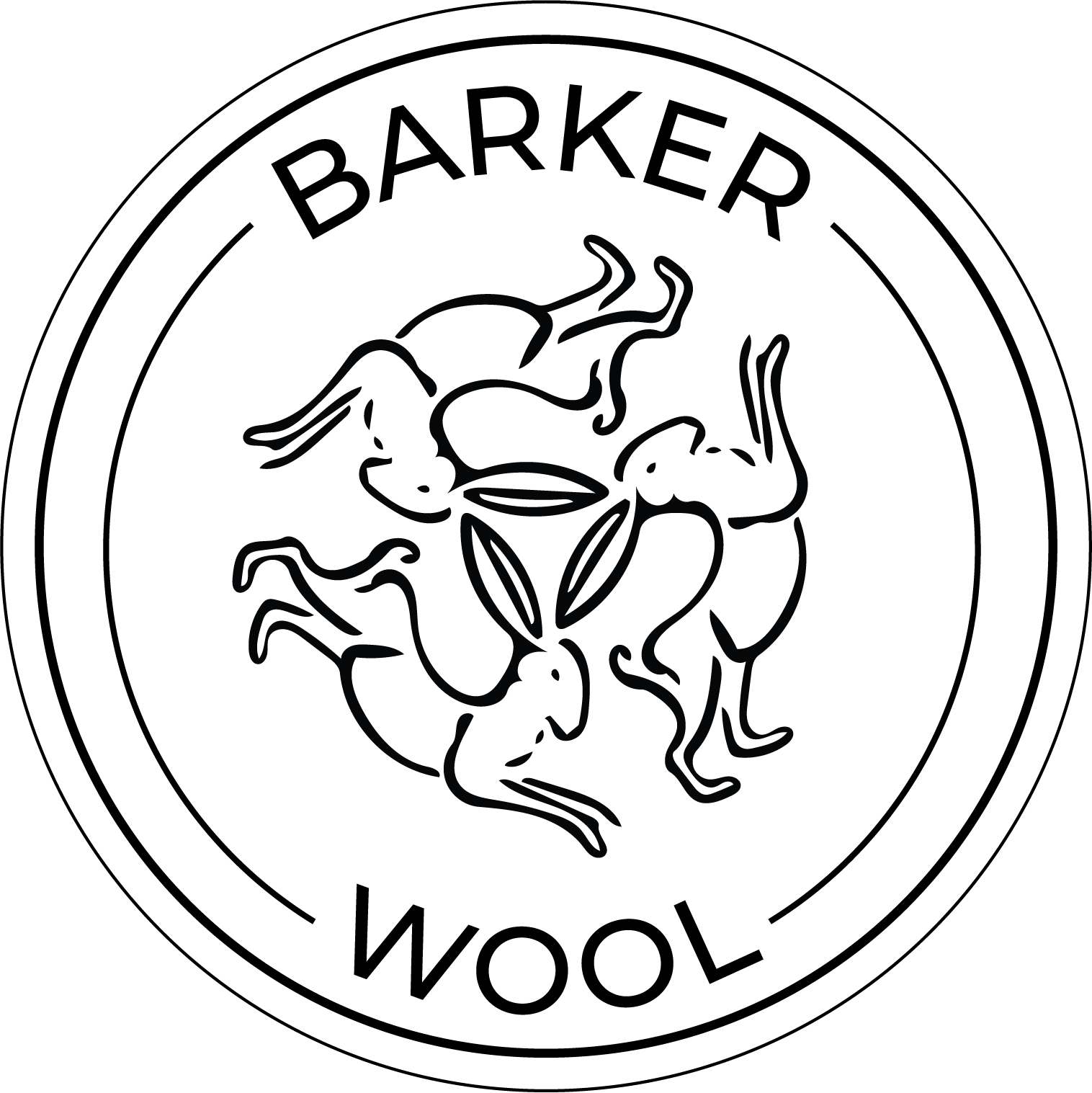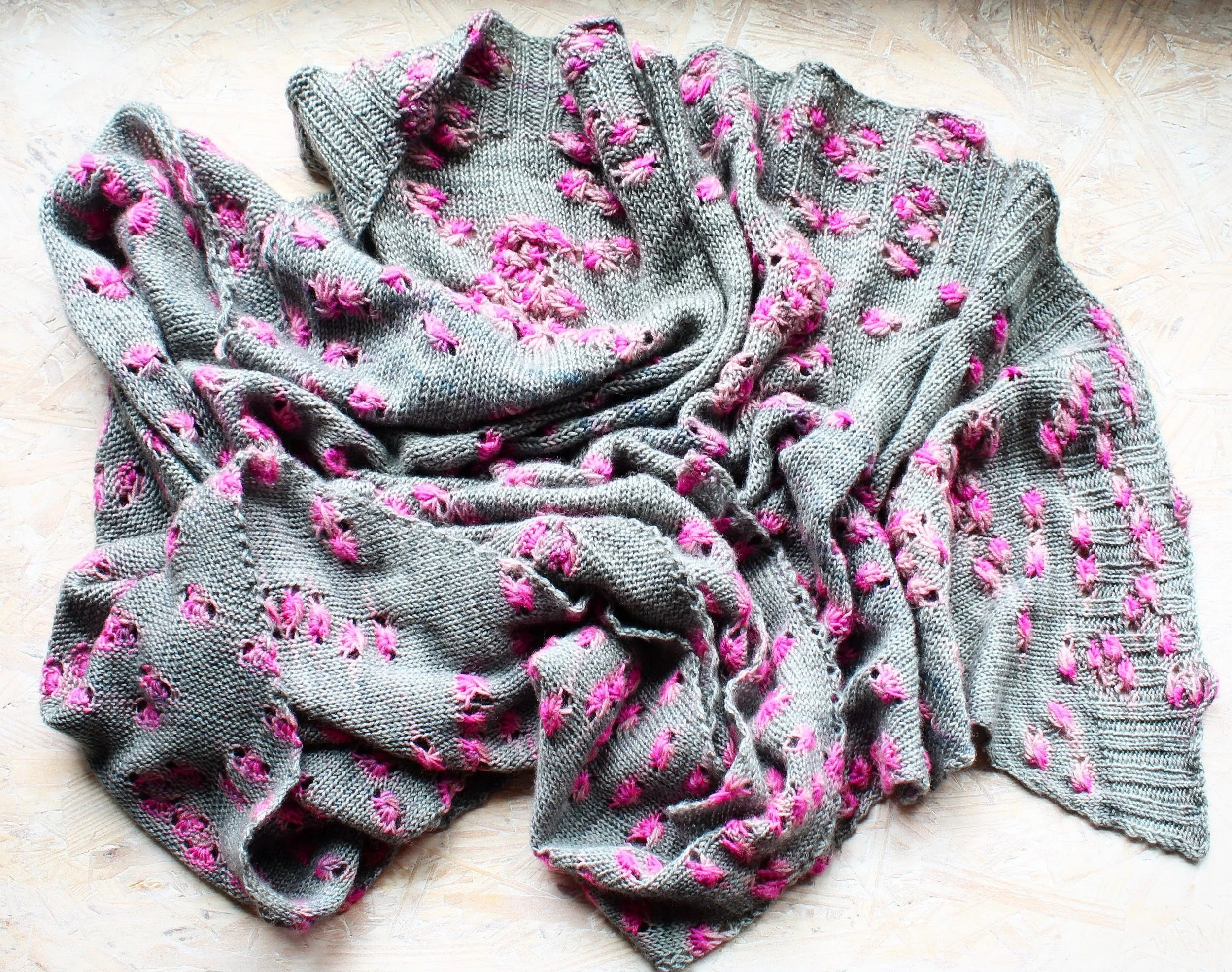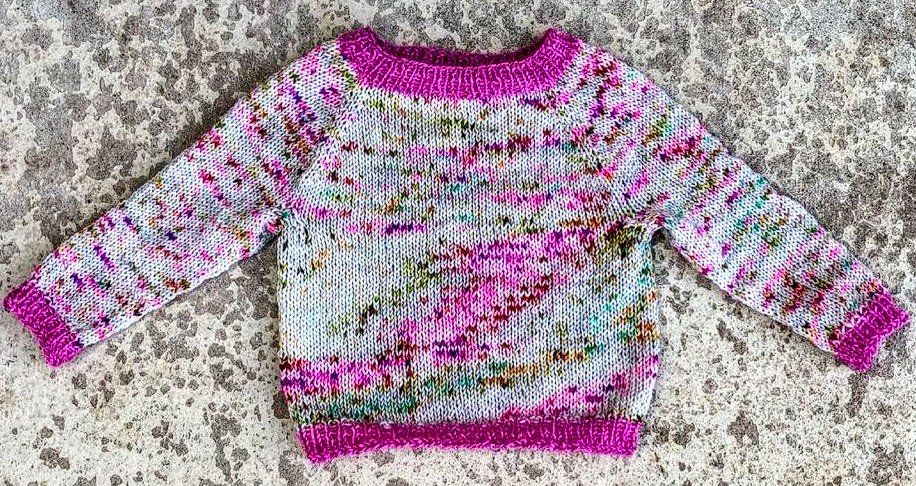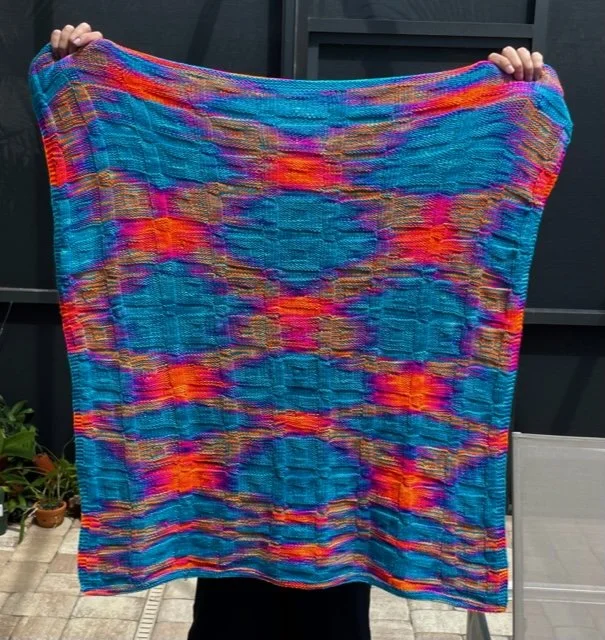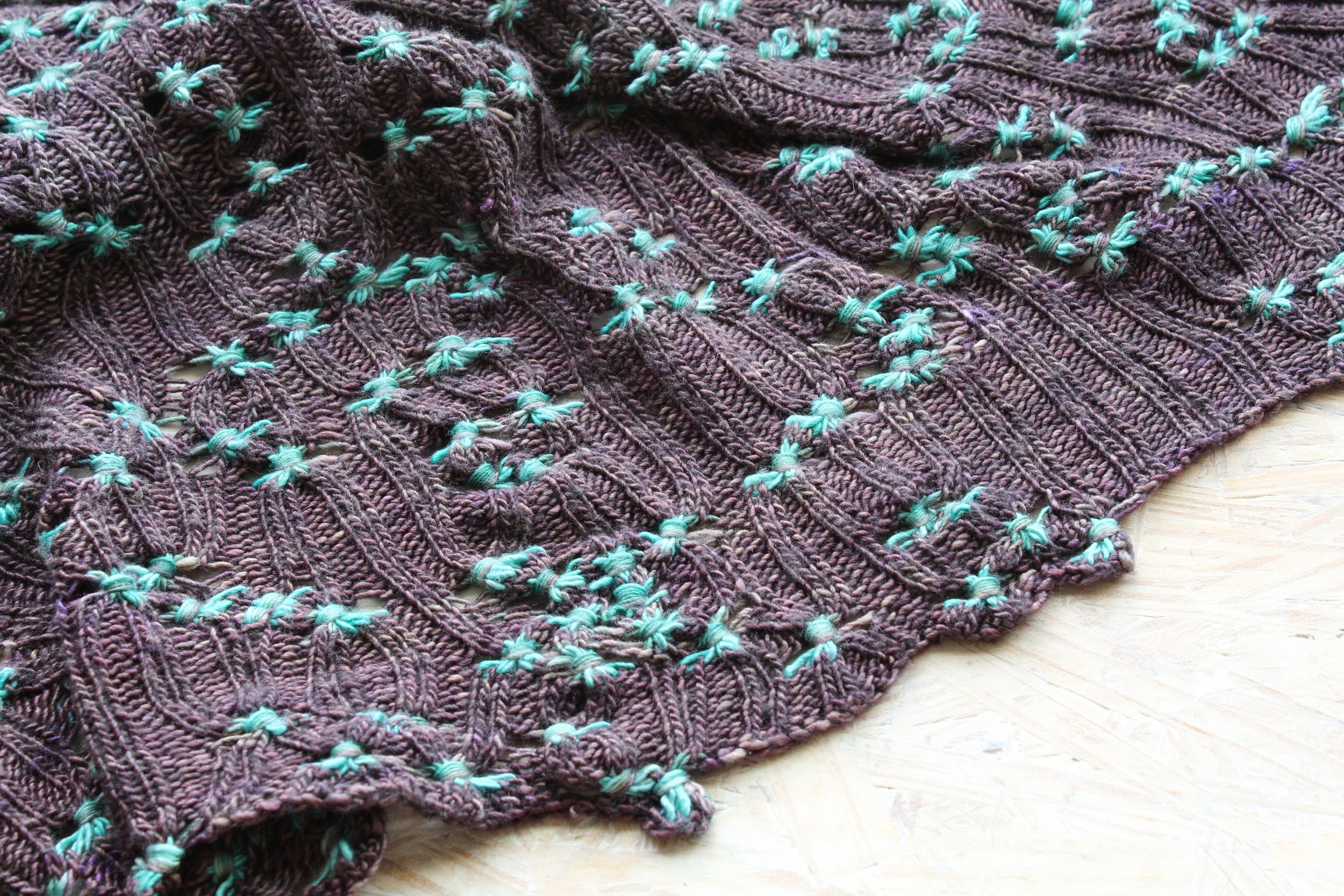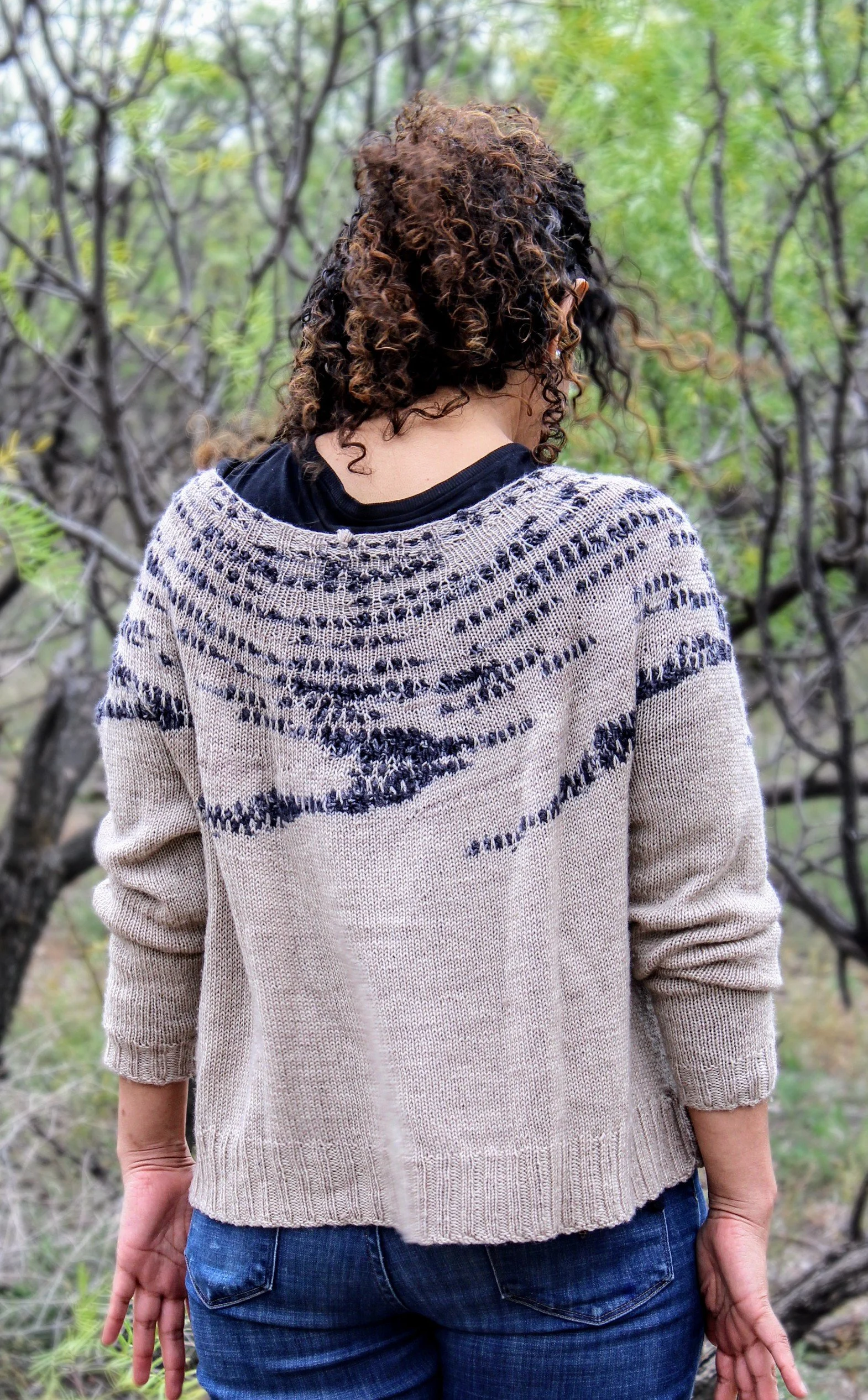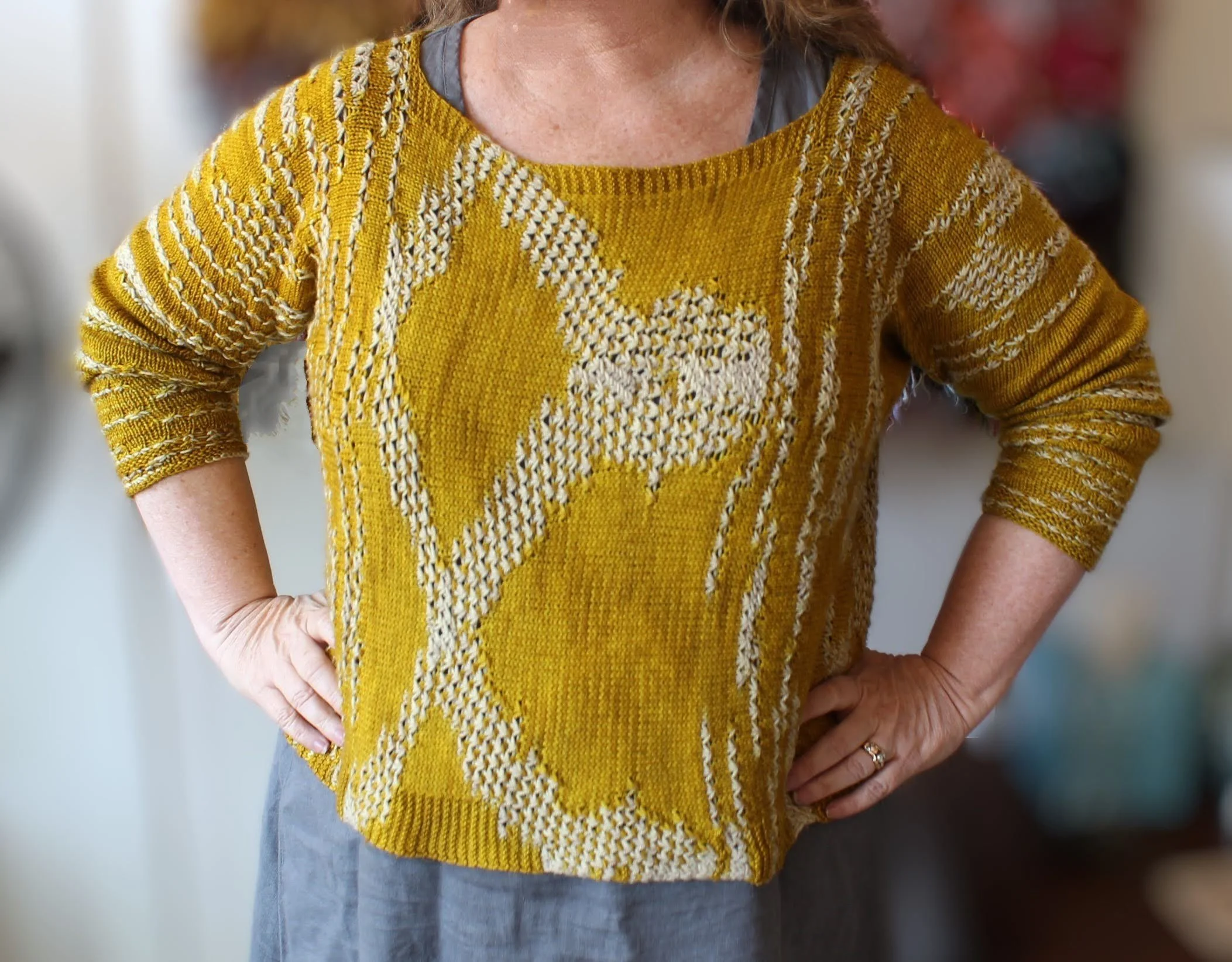My Journey Into Assigned Pooling
Everyone loves a good origin story, right? This is the story of how I developed Assigned Pooling.
My journey into Assigned Pooling started a few years ago when I was asked to teach a class on ways to use hand-dyed, multi-colored yarns. I immediately decided to teach ways to minimize the effects of organic pooling that typically occur when knitting with variegated skeins.
Organic pooling happens when regular color changes in the yarn start to stack, puddle, or swirl in recognizable patterns across a knitted fabric. Organic pooling is most affected by the direction of the knitting, flat vs. in the round, and the number of stitches per row or round.
As a fine artist and dyer, color theory and dynamics are second nature to me, so I love to splash beautiful colors onto blank wooly skeins in the dye pot. As a knitter and designer though, my heart has been broken more than once by the way variegated skeins pool. This pooling heartache led me on a quest to find the best ways to manage the pooling that can shift, change, and quite frankly, distract the eye.
I went straight to work compiling all of the tips and tricks I have collected through the years on ways to disguise organic pooling. I completed the course notes, taught the class, and sat back with a sense of accomplishment.
Pooling managed.
Then this little voice inside my head asked an interesting question. Now that I understood how pooling works and why it happens, what if I could make it a feature instead of seeing it as a problem to be managed? I started researching what had come before; surely my little voice was not the first to ask this question. I found a handful of patterns that altered basic stitches between color changes in variegated yarn and lots of information on Planned Pooling, but I wanted more.
Through my research I found that stitch-switching patterns alternate between basic stitches like knits and purls or knits and yarn-over lattice to change the texture between color changes in the yarn. They were interesting, but they didn’t make the impact I was searching for. Most of them didn’t really look that different from the organic pooling dispersion patterns that you see in plain knitting with multi-colored yarn. I knew I could take this further.
Planned Pooling, on the other hand, takes advantage of the rhythmic color changes in a skein of variegated yarn. The technique involves calculating the distance between these color changes to determine the number of stitches required to either make the colors stack up in columns when knitting in the round or crisscross in argyle fashion when knitting flat rows. It produces stunning results when done correctly, but it seemed too rigid for me. I wanted something that really highlighted the color changes in the yarn but didn’t rely on measurements and calculations or was limited by shape or fabric size to work.
Using textured knit stitches is one of my favorite ways to disguise organic pooling in a project. I had spent the better part of a year combing through old stitch dictionaries and adding new texture stitches to my knitting bag of tricks while researching my class. So I thought, what if I could isolate those same textures and confine them to occur just within a specific, limited space of an accent color within the yarn? I had featured one stitch in my class: the Anemone Stitch. It was my current darling at the time, and I used it in my Wildflower Shawl pattern as an effective example of how to move yarn in ways to minimize the look of organic pooling. Could I isolate that texture pattern and make it work for this idea?
I had to find out, so I ran to my dye shop, threw three skeins of my favorite BFL fingering into a dye pot and dyed my first batch of the colorway, Blossom. I waited impatiently for the dye to exhaust, but I couldn’t wait for the skeins to fully dry before I wound the first into a cake. I quickly cast on a few stitches and started knitting a simple right triangle shawl. I could hardly wait for the first color change to come up in the working yarn. When it did, I knit a series of short rows to form the first isolated version of the Anemone Stitch, and my first Floret Cluster was born.
That experiment became the very first Float Shawl.
The Original Float Shawl, Photo: Dawn Barker
I needed a name for this technique, so I decided to call it Assigned Pooling because different stitches are assigned to the color changes within the skein. In other words, knit the background color of the yarn using one stitch and then stop and make a special texture stitch when the accent color occurs. The way yarn is dyed decides where the special texture stitches will fall, but the knitter bends the accent color into the assigned texture. This technique definitely has its roots in the stitch-switching patterns of yore, but Assigned Pooling is different. I sought a new direction with more highly textured stitches that formed motifs that are immediately completed rather than textures that are typically reconciled over a series of rows or switched between basic knit and purl stitches.
From a dyer’s perspective, I had been dying quarter-dyed skeins for years, that is skeins in which about ¾ of the skein is dyed one color and the remaining ¼ in another. This dye style is not new, but many of my customers struggled with what to knit with them since they are guaranteed to pool in bold ways.
Assigned Pooling is my answer.
This technique lit a fuse in me as a designer. At this writing, I have spent the last two years of my life researching and developing more stitch combinations suited to this system of Assigned Pooling. I have developed a wide range of colorways that all work with AP, from simple, two-color splits to complex banded colorways that give depth and movement through secondary organic pooling patterns that form in the background behind the texture stitches.
All of my patterns (there are currently 15) are built on simple, wearable shapes that are easy to execute and look more complicated than they actually are. I never expected this idea to take off like it has. Now other dyers and designers are taking AP in different directions and breathing their ideas into the technique. I’m seeing it combined in new ways with stripes and lace and even brioche. Thousands of knitters around the world have jumped into the pool with me, and for that, I am forever grateful.
Organic Pooling:
This is one example of a typical result of knitting with a variegated yarn.
Note the color swirl around the body of this adorable baby sweater knit in a speckled colorway.
Photo courtesy of Amber Hastings
Planned Pooling:
Planned Pooling is the result of carefully calculating the gauge and the number of stitches needed to make the color repeats stack up in columns when knit in the round like in this cowl pattern,
Photo: Dawn Barker
or when knit in flat rows as in Remy’s Baby Blanket. This stunning example of Planned Pooling was shared with me by Keith Leonard of Yarn Snob Yarns. This pattern and the yarn needed for it can be found at knitsalldone.com.
You can also follow Keith on Instagram: @yarn_snob_keith.
Photo courtesy of Keith Leonard
Yet another beautiful example of the argyle-type pattern that typically forms in Planned Pooling when knit in back and forth rows is this gorgeous wrap designed and knit by Dana Fehrenbach.
You can find her at Danafehrenbachdesigns.com and on Instagram: @therunawayknitter.
Photo courtesy of Dana Fehrenbach
The Assigned Pooling Difference
My goal with Assigned Pooling has always been to mimic the look of embroidery on knits by making highly textured motifs like the Floret Cluster in my Float Shawl above or as in my Glide Shawl pictured here.
Photo: Dawn Barker
Or the bobbles shown here on my Pop shawl:
Photo: Dawn Barker
My Spool Stitch is another motif stitch that I often use to create a flower-like cluster as seen here in my Twinkle Shawl.
Photo: Dawn Barker
Assigned Pooling stitches can also be made in long chain texture stitches like the Tiny Bobble stitch that I used in my Murder Of Crows sweater,
Photo: Dawn Barker
Or my Sprout stitch that I used in my Llano sweater.
Photo: Dawn Barker
As you can see, Assigned Pooling is a versatile technique that can be applied in many different ways to create intriguing surface design on a field of knitting in a whole new way. My complete catalogue of Assigned Pooling patterns can be found under the PATTERNS tab above, or on Ravelry in Dawn Barker Designs. My Assigned Pooling yarns can be seen under the HOUSE COLLECTION tab above. Look for these specially designed skeins labeled AP or AP Banded.
